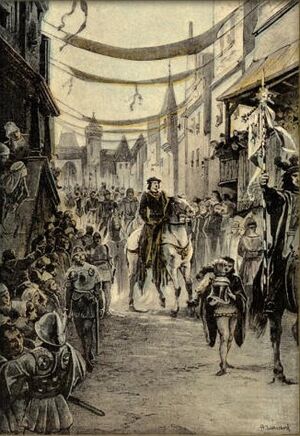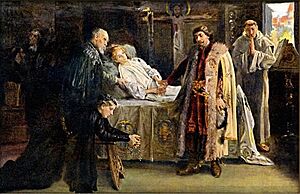Ladislaus the Posthumous facts for kids
Quick facts for kids Ladislaus V |
|
|---|---|
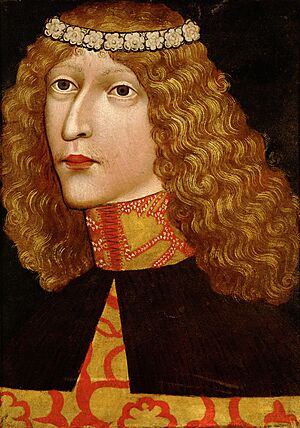
Anonymous painting, 1457
|
|
| Duke of Austria | |
| Reign | 22 February 1440 – 23 November 1457 |
| Predecessor | Albert V |
| Successor | Frederick V |
| Regent | Frederick V (1440–1452) |
| King of Hungary and Croatia contested by Vladislaus I, 1440–1444 |
|
| Reign | 15 May 1440 – 23 November 1457 |
| Coronation | 15 May 1440 |
| Predecessor | Albert |
| Successor | Matthias I |
| Regents |
|
| King of Bohemia | |
| Reign | 28 October 1453 – 23 November 1457 |
| Coronation | 28 October 1453 |
| Predecessor | Albert |
| Successor | George |
| Regent | George of Poděbrady (1453–1457) |
| Born | 22 February 1440 Komárom, Kingdom of Hungary |
| Died | 23 November 1457 (aged 17) Prague, Kingdom of Bohemia |
| Burial | St. Vitus Cathedral |
| House | Habsburg |
| Father | Albert II of Germany |
| Mother | Elizabeth of Luxembourg |
Ladislaus V, often called Ladislaus the Posthumous, was born on February 22, 1440, and died on November 23, 1457. He was the Duke of Austria and the King of Hungary, Croatia, and Bohemia. He got the name "Posthumous" because he was born after his father, Albert II of Germany, had already passed away.
Albert II, his father, was the Duke of Austria and also the King of Hungary and Bohemia. On his deathbed, Albert wanted all his lands to go to his future son. However, only the nobles and leaders of Austria agreed to his wish. In Hungary, many lords worried about attacks from the Ottoman Turks. They chose Vladislaus III of Poland as their king instead. In Bohemia, the noblemen and towns did not accept that Albert's family should automatically inherit the throne.
After Ladislaus was born, his mother, Elizabeth of Luxembourg, quickly had him crowned King of Hungary on May 15, 1440. But the Hungarian assembly (called the Diet) said this crowning was not valid and elected Vladislaus as king. This started a long civil war. Ladislaus spent much of his childhood under the care of his distant cousin, Frederick III, who was also the Holy Roman Emperor.
Contents
Life of Ladislaus
His Birth and Family
Ladislaus was born after his father, Albert II of Germany, died. His mother was Elizabeth of Luxembourg. Albert was the Duke of Austria. Elizabeth was the only child of Emperor Sigismund, who was King of Bohemia and Hungary.
When Sigismund died in 1437, Albert was chosen as King of Hungary. In Bohemia, Albert became king after defeating Casimir IV Jagiellon, who was supported by some Hussite lords.
Albert planned to fight the Ottoman Turks, who were raiding southern Hungary. But he became very ill. Before he died, he said that if his wife had a son, that child should inherit Austria, Bohemia, and Hungary. He also named his wife and his cousin, Frederick III, as guardians for his future child. Albert died on October 27, 1439.
Many Hungarian lords were afraid of Ottoman attacks. They did not accept Albert's last wishes. They offered the crown to Vladislaus III of Poland, who was only 16. They hoped Queen Elizabeth would marry him.
Queen Elizabeth, who was 31, seemed to agree to marry Vladislaus. But her doctors thought she would have a son. So, she secretly arranged for the Holy Crown of Hungary to be stolen from Visegrád castle. Her chambermaid, Helene Kottanner, helped steal the crown. They gave it to the queen on the day she gave birth. This was seen as a miracle. Ladislaus was born in Komárom (now Komárno, Slovakia) on February 21, 1440. He was named after King St. Ladislaus.
Early Challenges and Civil War
The leaders in Austria accepted Ladislaus as their ruler. They made Frederick III his regent, which means he would rule for Ladislaus until he was old enough. In Bohemia, only the Catholic lords accepted Ladislaus's right to rule.
Queen Elizabeth tried to convince the Hungarian lords to stop talking to Vladislaus III. But they refused and elected Vladislaus as king on March 8, 1440. Vladislaus promised to marry Queen Elizabeth and protect her son's lands.
The queen refused to agree. She quickly took Ladislaus to Székesfehérvár, where Hungarian kings were traditionally crowned. On May 15, Ladislaus was crowned king. He was just a baby. During the ceremony, his mother's cousin, Ulrich II, Count of Celje, held the crown over his head. Ladislaus cried during the long ceremony.
Six days later, Vladislaus III entered Buda. Queen Elizabeth fled with Ladislaus. Many powerful lords and towns stayed loyal to Ladislaus. But most noblemen preferred Vladislaus. They hoped he could better defend Hungary from the Ottomans.
A civil war began. On June 29, 1440, the Hungarian Diet said Ladislaus's crowning was not valid. They said that choosing a king depends on the people's will. On July 17, Vladislaus was crowned king with a different crown.
Queen Elizabeth needed money for the war. She made a deal with Frederick III in November. She gave him the Holy Crown of Hungary and made him Ladislaus's guardian. After this, Ladislaus lived at Frederick III's court, mostly in Wiener Neustadt.
Queen Elizabeth hired a Czech soldier named John Jiskra of Brandýs. He took control of many towns in northern Hungary. But Vladislaus's commanders, Nicholas Újlaki and John Hunyadi, defeated Ladislaus's supporters in a battle in 1441. Vladislaus took control of more parts of Hungary.
Queen Elizabeth and Vladislaus signed a peace treaty in December 1442. The queen accepted Vladislaus as king but kept her son's claim to the throne. A few days later, the queen died suddenly. Ladislaus became an orphan before his third birthday.
Years as a Ward
After his mother died, Ladislaus's claim to the thrones of Hungary and Bohemia was protected by John Jiskra and Ulrich II of Rosenberg. Most of Hungary was still ruled by Vladislaus. In Bohemia, George of Poděbrady led the moderate Hussites.
Ladislaus's rival, Vladislaus, died fighting the Ottomans in the Battle of Varna in November 1444. The next year, the Hungarian lords agreed to accept Ladislaus as king if Vladislaus did not return by June 1445. But they also said they would choose a new king if Frederick III, Ladislaus's guardian, did not release Ladislaus and the Holy Crown.
The Hungarian lords also chose seven "Captains in Chief" to rule the kingdom. John Hunyadi was one of them. Frederick III attacked Hungary and captured some fortresses. Since Frederick III refused to release Ladislaus, the Hungarian Diet elected John Hunyadi as regent in June 1446. Hunyadi ruled most of Hungary, but not the areas controlled by Frederick III, John Jiskra, or the Counts of Celje.
Ladislaus received a good education at Frederick III's court. A special Latin grammar book was made for him. Aeneas Silvius Piccolomini, who later became Pope, wrote a letter to the ten-year-old Ladislaus in 1450. He advised Ladislaus to read classical books and the Bible. He also stressed the importance of physical training.
As regards a boy's physical training, we must bear in mind that we aim at implanting habits which will prove beneficial through life. So let him cultivate a certain hardness which rejects excess of sleep and idleness in all its forms. Habits of indulgence – such as the luxury of soft beds, or the wearing of silk instead of linen next the skin – tend to enervate both body and mind. ... Childish habits of playing with the lips and features should be early controlled. A boy should be taught to hold his head erect, to look straight and fearlessly before him and to bear himself with dignity whether walking, standing, or sitting. ... Every youth destined to exalted position should further be trained in military exercises. It will be your destiny to defend Christendom against the Turk. It will thus be an essential part of Your education that you be early taught the use of the bow, of the sling, and of the spear; that you drive, ride, leap and swine. These are honourable accomplishments in everyone, and therefore not unworthy of the educator's care. ... Games, too, should be encouraged for young children – the ball, the hoop – but these must not be rough and coarse, but have in them an element of skill. ... In respect of eating and drinking the rule of moderation consists in rejecting everything which needlessly taxes digestion and so impairs mental activity. At the same time fastidiousness must not be humoured. A boy, for instance, whose lot it may be to face life in the camp, or in the forest, should so discipline his appetite that he may eat even beef. The aim of eating is to strengthen the frame; so let vigorous health reject cakes or sweets, elaborate dishes of small birds or eels, which are for the delicate and the weakly. ... As regards the use of wine, remember that we drink to quench thirst, and that the limit of moderation is reached when the edge of the intellect is dulled. A boy should be brought up to avoid wine; for he possesses a store of natural moisture in the blood and so rarely experiences thirst.
—Aeneas Silvius Piccolomini: On the Education of Children
John Hunyadi and Frederick III signed a peace treaty in October 1450. They agreed that Ladislaus would stay with Frederick until he turned eighteen. But the Austrian nobles were unhappy because the legal age for adulthood was usually twelve or sixteen.
Frederick took Ladislaus with him to Rome in 1451, where Frederick was crowned Holy Roman Emperor. When they returned, Frederick still refused to give up Ladislaus. This made the Austrian nobles rebel in 1452. They joined with Hungarian and Bohemian Catholic lords. They demanded Ladislaus be handed over. The rebellious Austrian lords surrounded Wiener Neustadt. This forced Emperor Frederick III to give Ladislaus to Ulrich of Celje on September 4.
Ladislaus's Reign
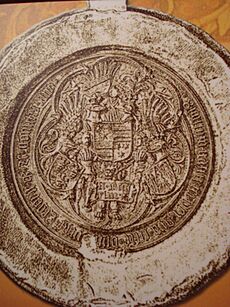
Ulrich of Celje took Ladislaus to Vienna. Important Hungarian lords, including Ladislaus Garai and Nicholas Újlaki, visited Ladislaus. John Hunyadi also joined them. Hunyadi resigned as governor in early 1453. Ladislaus made Hunyadi "captain general of the kingdom." This meant Hunyadi could keep the royal castles he had and manage royal money.
In January 1453, the Hungarian Diet officially recognized Ladislaus as the lawful king. He offered forgiveness to those who had supported Vladislaus against him. Ladislaus also restored important government offices that had not been working for ten years.
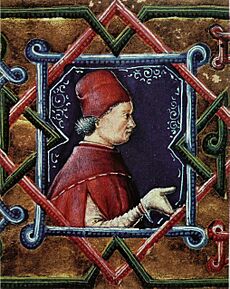
Ladislaus returned to Vienna. Ulrich of Celje became his most important advisor. Celje made a deal with George of Poděbrady in April. Ladislaus then confirmed Poděbrady's role as governor in Bohemia. Ulrich of Celje also made alliances with other Hungarian lords. These alliances were against John Hunyadi and Ulrich Eytzinger, an Austrian noble. Eytzinger later convinced Ladislaus to remove Ulrich of Celje from his court.
Ladislaus was crowned King of Bohemia in Prague on October 28, 1453. This ended the long period without a king. Ulrich Eytzinger, John Hunyadi, and George Poděbrady were all there and signed a treaty. Ladislaus stayed in Prague for a year. George Poděbrady kept him from talking to his Austrian and Hungarian advisors.
Ladislaus left Prague in November 1454. He visited Silesia and Moravia, where the local leaders showed him respect. He returned to Vienna in February 1455. Ulrich of Celje convinced Ladislaus to bring him back to court. Ulrich of Celje became the young king's main advisor for Austrian affairs again. Ladislaus visited Buda and convinced Hunyadi to give up some royal money and castles.
Pope Callixtus III called for a crusade against the Ottoman Turks. News of Sultan Mehmed II's plans to invade Hungary reached them in late 1455. Ladislaus came to Hungary in February 1456. He held a meeting that called for everyone to join the army and approved a special tax to pay for defense. Ladislaus left Hungary and returned to Vienna before the Sultan's army reached the border.
Sultan Mehmed II attacked Belgrade in July 1456. John Hunyadi, with the help of many common people, defended the fortress on July 22. Two weeks later, Hunyadi died from a disease that spread in Belgrade.
Ladislaus returned to Hungary in September, with Ulrich of Celje and an army. Ladislaus made Ulrich of Celje "captain general." They wanted to take back all the royal castles and money that Hunyadi's son, also named Ladislaus Hunyadi, held. The younger Ladislaus Hunyadi seemed to agree at first. He invited the king and Ulrich of Celje to Belgrade. But after they entered the fortress, Hunyadi's soldiers attacked and killed Ulrich of Celje on November 9.
The king's army quickly broke apart, and Ladislaus found himself a prisoner. He went with Ladislaus Hunyadi to Temesvár (now Timișoara, Romania). Hunyadi only let the king leave after Ladislaus made him captain general and promised not to get revenge for Ulrich of Celje's death.
From Temesvár, Ladislaus went to Buda. He realized that most Hungarian nobles were against Ladislaus Hunyadi. Ladislaus convinced Ladislaus Hunyadi to bring his younger brother, Matthias, to Buda. As soon as Matthias arrived on March 14, 1457, Ladislaus had both Hunyadi brothers arrested. The royal council found them guilty of high treason. Ladislaus Hunyadi was executed on March 16.
The Hunyadi brothers' mother, Elizabeth Szilágyi, and her brother, Michael Szilágyi, started a rebellion against the king. This led to a civil war. Ladislaus appointed John Jiskra to lead the royal army. In early June, Ladislaus left Hungary for Vienna, taking the captive Matthias Hunyadi with him.
From Vienna, Ladislaus went to Prague. He died unexpectedly on November 23, 1457. People at the time thought he was poisoned. But studies of his skeleton suggest he died from bubonic plague or leukemia. He was buried in St. Vitus Cathedral in Prague.
Ladislaus never married. He was the last male member of his family line, the "Albertinian Line" of the House of Habsburg. After his death, Emperor Frederick III and his brother, Albert VI, took over Austria. In Hungary, Matthias Hunyadi was elected king. In Bohemia, George of Poděbrady was elected king.
Images for kids
See also
 In Spanish: Ladislao el Póstumo para niños
In Spanish: Ladislao el Póstumo para niños


